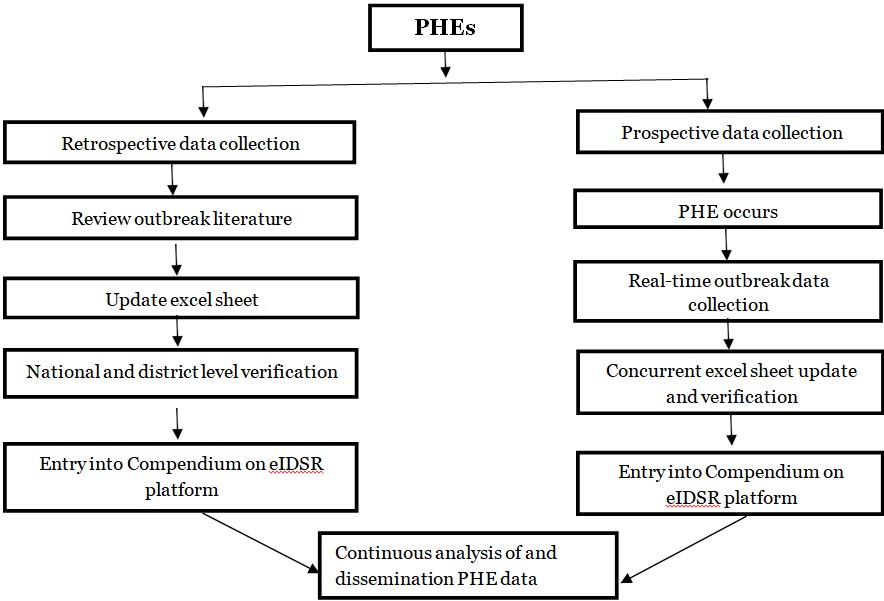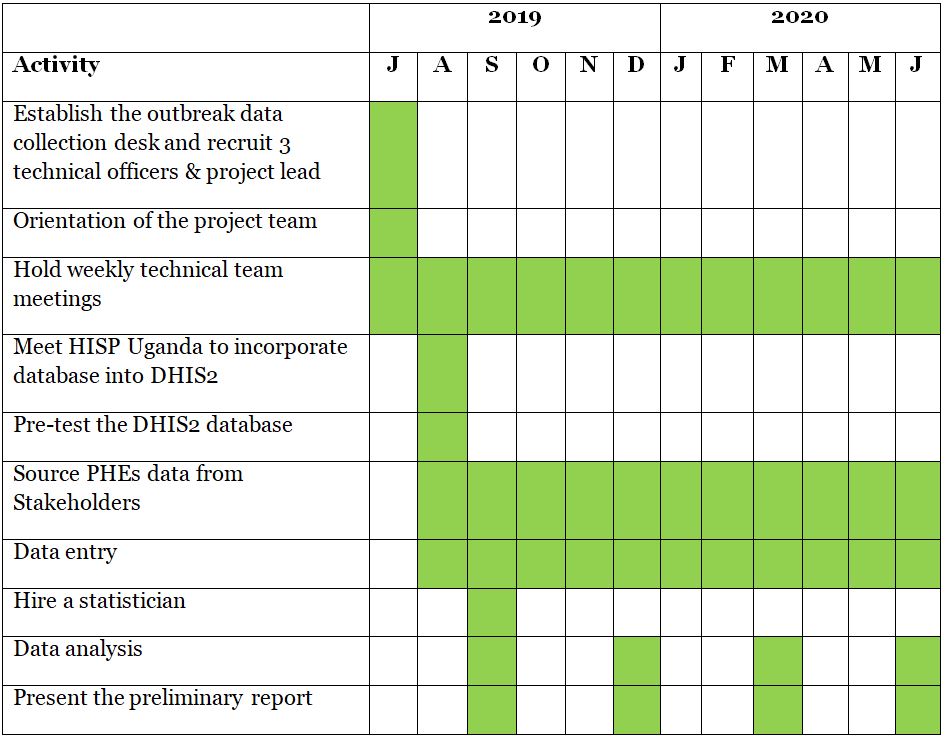Recover your password.
A password will be e-mailed to you.
Implementing Outbreak Timeliness Metrics in Uganda, July 2019 – June 2020 Project
Background
Disease outbreaks, especially due to communicable diseases, continue to prevail in Uganda despite efforts towards their effective prevention (1). Between August 2017 and August 2018 alone, eight disease outbreaks occurred in Uganda causing significant morbidity and mortality (2). Viral Haemorrhagic Fevers (VHF) and other infectious diseases are prevalent in Uganda.
To mitigate such events, the Uganda Ministry of Health (MoH) embarked on enhancing a real-time information system for epidemic preparedness, prevention, detection and response to Public Health Emergencies (PHEs), among other priority objectives as guided by International Health Regulations (IHR) 2005. Additionally, during the 2017 Joint External Evaluation of Uganda’s IHR core capacities, Uganda committed to prioritizing preparedness through institution of a mechanism for regularly updating her hazard or risk profile (5). These interventions have contributed greatly in preparedness and response to PHEs in recent years, with a fivefold increase in detection of VHFs since 2010 and, a reduction in the laboratory turnaround time to confirm outbreaks from 2 weeks prior 2010 to 2.5 days (3).
Whereas preparedness to respond to PHEs is enriched when historical data informs forecasting for future epidemics, documentation of Uganda’s past PHEs and her performance during the response to these PHEs remains a challenge (4,5). Therefore, a retrospective identification, characterization and documentation into one central database of previous PHEs and responses mounted is critical for onward PHE prediction and mitigation (4). The database created will also be a reference point for the Uganda’s National Multi Hazard Preparedness and Response Plan.
The Uganda Public Health Fellowship Program (PHFP) is well placed as a partner of choice in creating the envisioned central database for Uganda. The two-year training-in-service program, aimed at equipping public health professionals with the skills needed to manage public health challenges, has investigated and responded to more than 80 disease outbreaks and PHEs since 2015, and has significantly contributed to documentation of currently available information on PHEs in Uganda.
Goal
To establish a comprehensive retrospective and prospective information depository on Public Health Emergencies in Uganda.
Objectives
The objectives are to collect outbreak-related data, aggregate it and enter into a database and periodically analyse it to inform outbreak response in the Uganda. Development of the database will take place from July 2019 – June 2020.
Deliverables
The project deliverables will include:
- An excel form to collect retrospective data on PHEs that occurred in Uganda since 2000
- An excel form to collect real-time data on PHEs occurring in Uganda
- A web-based database housed on the DHIS2 of retrospective and prospective PHEs that have occurred in Uganda since 2000
- A detailed trend analysis of PHEs that occurred in Uganda since 2000 to
This analysis will assess the country’s progress in timeliness of PHEs response, in regards to the key outbreak metrics, including; PHE start, detection, notification, verification, laboratory confirmation, public health response, public communication, among others. - A quarterly report to the Ministry of Health (MoH) National Task Force, entailing the results of the analysis to inform the MoH on outbreak response performance
- A comprehensive bi-annual project report
Project design and methods
We will set up an outbreak data collection desk, with staff responsible for collection of prospective and retrospective outbreak data. We will rely on both the indicator-based surveillance and event-based surveillance systems to detect outbreaks and initiate the data collection process. The prospective data will be collected in real time, in collaboration with the PHEOC, the national reference laboratories and the districts of outbreak occurrence and updated in the depository. Retrospective data collection will require consultation with the key partners in outbreak response to identify all available data.
When an outbreak is confirmed at the district, the response team includes the district and national teams of which UPHFP is part of. Data are initially recorded by field staff on paper forms and entered into situation reports each day, which are shared with the PHEOC and other partners. Aggregate outbreak data and milestones will initially be entered into an MS Excel form for review and confirmation by the project team, who are part of the National Rapid Response Team, the outbreak data will then be entered into a pre-designed data entry tool on the eIDSR platform of the DHIS2. The potential to automatically upload the Excel forms into the eIDSR PHE Compendium will be explored by the IT team.
Retrospectively, we shall search for, identify and review existing information on PHEs since 2000; categorize the PHEs identified; identify relevant variables to be included in the database basing on information gathered; develop a data collection tool basing on information gathered; compare developed tool with already existing tools (if any) so as to validate and/or improve existing tools.
Variables to be included in the database will focus on the duration, magnitude, temporality, spatiality, fatalities and response efforts towards PHEs, for example, verification, laboratory confirmation, notification to WHO, outbreak declaration, among others.
Data collection and data assembly
Data on the key outbreak metrics will be collected prospectively and retrospectively. Prospectively, we will collect data in real-time through liaison with the Public Health Emergency Operations Centre (PHEOC), national laboratories, districts and other partners who play key roles in outbreak response.
Retrospective data collection will involve review of published literature, end of outbreak reports, epidemiological investigation line-lists, situation reports, laboratory records, correspondence between key response personnel, PHFP presentations, seasonal data from the National Emergency Coordination and Operations Centre (NECOC), print and electronic media or any other official reports.
Initial outbreak data collected will be entered into pre-designed MS Excel forms, checked for consistency before entering it into the PHEs database/compendium, managed by the Uganda Public Health Fellowship Program and the PHEOC. The IT developers modifying the eIDSR system will explore methods for automatically uploading the Excel forms into the compendium. Access to this database will only be granted by the above two institutions, in consultation.
Below is a flowchart illustrating the data collection, verification and entry into the PHE compendium.

Analysis plan
The project team will conduct a quarterly analysis of the outbreak metrics data. We will analyse the time to outbreak detection, response, and other activities for each of the key outbreak response components and use means and medians to compare and assess for an improvement in response over the years.
We will generate frequencies & trends for disease occurrence over the years. We will conduct a survival analysis to understand time to occurrence of each of the key outbreak response components.
Plan for interpretation and sharing results
Information from the quarterly analysis will be compiled into clear, concise and easy to understand reports which will be presented and circulated to the Uganda National Task Force. These reports will be premised on to improve Uganda’s preparedness and response efforts to PHEs. Articles will be written in MoH bulletins and manuscripts prepared for submission to peer reviewed journals to reach the wider global community.
Potential challenges and Limitations
The main challenge we envisage will be retrospective data verification to ensure consistency. The available data on outbreak that have occurred in Uganda is scant and scattered in the various departments of Ministry of Health, other line ministries and partners involved in outbreak response. It will therefore require thorough consultations with these key players to fully update our outbreak metrics.
Implementation Timelines

References
- Lukwago L, Nanyunja M, Ndayimirije N, Wamala J, Malimbo M, Mbabazi W, et al. The implementation of Integrated Disease Surveillance and Response in Uganda: a review of progress and challenges between 2001 and 2007. Health Policy Plan. 2013 Jan 1;28(1):30–40.
- Mbonye AK, Sekamatte M. Disease outbreaks and reporting in Uganda. The 2018 Dec;392(10162):2347–8.
- Shoemaker TR, Balinandi S, Tumusiime A, Nyakarahuka L, Lutwama J, Mbidde E, et Impact of enhanced viral haemorrhagic fever surveillance on outbreak detection and response in Uganda. Lancet Infect Dis. 2018 Apr;18(4):373–5.
- November 27, 2013. Database tracks disease outbreaks, vaccinations reported since 1888 [Internet]. [cited 2018 Apr 6]. Available from: https://www.healcom/infectious-disease/practice- management/news/online/%7B02b0ffa2-ac6e-4d52-b364- a97de8165960%7D/database-tracks-disease-outbreaks-vaccinations-reported-since- 1888
- Reis BY, Kohane IS, Mandl KD. An Epidemiological Network Model for Disease Outbreak Meyers LA, editor. PLoS Med. 2007 Jun 26;4(6):e210.
